Can Breading in Chicken Nuggets Trigger a Wheat Allergy?
Worst Foods To Order In A Restaurant When You're Gluten-Free
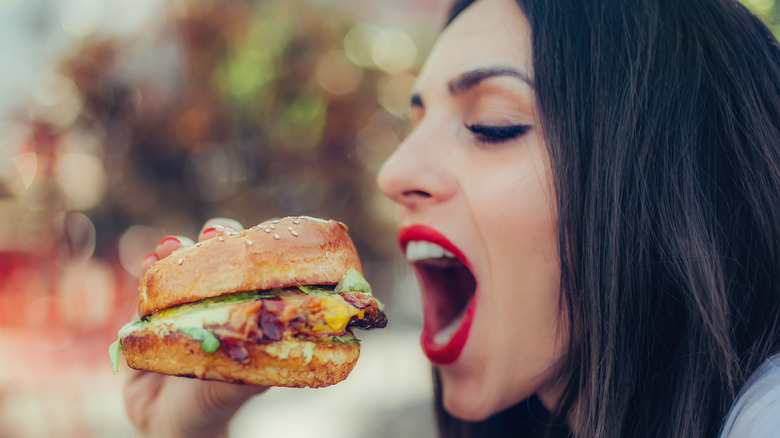
Shutterstock
While there are lots more gluten-free options available in restaurants than even a few years ago, you still need to know what foods present the most challenges, questions to ask, and alternatives to look for if you have a problem digesting gluten. While people with milder gluten intolerance may not notice accidental gluten ingestion, people with celiac disease who need to be on a gluten-free diet to keep their illness in check can get seriously sick from it.
With celiac disease, an autoimmune disease thought to affect one in ten people worldwide, ingestion of gluten (in wheat, barley, and rye) leads to damage of the small intestine, as the body's immune response attacks the microvilli, small fingerlike projects that help the body absorb nutrients. Short term symptoms may include bloating, diarrhea, abdominal pain, and other GI issues, but in the long term, untreated celiac disease may cause malabsorption and may contribute to other health conditions.
As a dietitian, I help people on restricted diets navigate restaurants. For this story I also spoke with Wisconsin-based Registered Dietitian Alicia Slusarek, who has celiac disease herself. For a worry-free meal, she recommends, "Choose a restaurant with a certified gluten-free kitchen or a restaurant with gluten-free foods indicated on the menu." Not possible? Then "you'll likely be customizing a dish to be gluten-free when it generally is not." Risky, yes, but not impossible. Read on to get the scoop on the worst choices — and what to order instead.
The bread basket
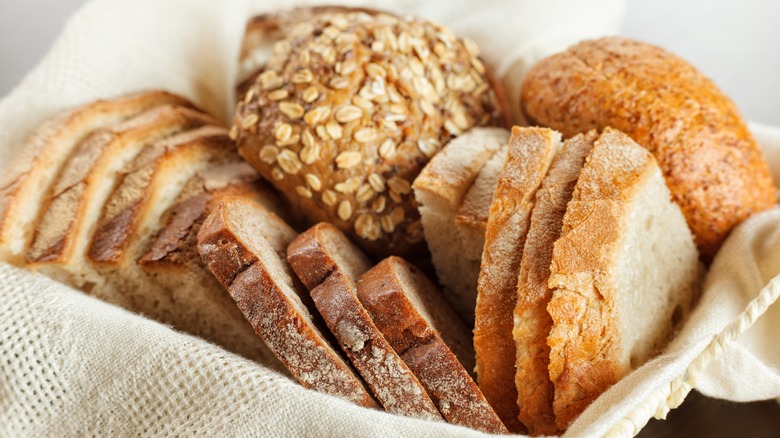
Shutterstock
This might sound obvious, but products made from wheat are a no-go for people with celiac disease. So that goes for dinner rolls, bread sticks, croissants, biscuits, crackers, pastries, and mini-muffins. Ask for gluten-free options, but double-check to see if they're served in the same basket or toasted up in the same toaster as gluten-containing varieties. Because cross-contamination is an issue, if a gluten-free bread picks up wheat-bread crumbs on its journey through the toaster, someone with celiac could still get sick.
Italian
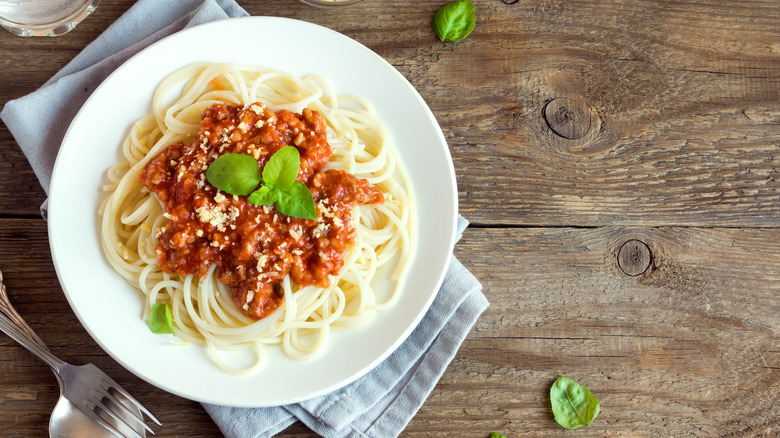
Shutterstock
Because wheat pasta contains gluten, you're best steering clear of spaghetti, linguine, penne, ravioli, and the like when you're eating Italian. Ditto pizza. If your heart is set on it though, says, Slusarek, "Ask for gluten-free bread, pasta, and pizza, but double-check whether it's prepped in the same toaster or oven."
Also be sure to ask about ingredients in sauces, meatballs, and other items that may have breadcrumbs or be prepared around gluten-containing items. If you're, like, "But they're meatballs," you're totally right, but traditionally, meatballs are made with breadcrumbs. Fried calamari, zucchini fritters, and eggplant, veal, or chicken parm are also off-limits because of their breading.
Scope out the meat, fish, and vegetable options instead. One of my personal favorite meals to order in an Italian restaurant is grilled branzino (sea bass) with broccoli rabe — pairs great with red wine. Another winner is calamari in red sauce. If you hate fish, chicken or steak with veggies is great. If that's not an option in your local place, Slusarek isn't against bringing your own gluten-free bread or even snacks (nuts would be super-convenient) to supplement a humble salad. Just leave off croutons and do oil and vinegar instead of bottled dressing.
Seafood
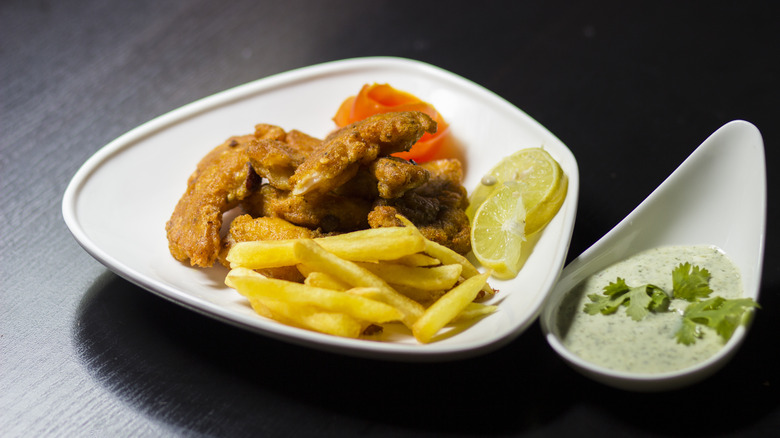
Shutterstock
I know, I just told you to order seafood, but at a seafood restaurant there are still some dangerous options. Just say no to fried stuff like fish sticks and clam strips — that breading often contains gluten. Crab cakes and even some soups may contain gluten because of breadcrumbs or flour. Oyster crackers are another no-go. Even when an item itself is gluten-free (like fries) or the breading doesn't contain gluten, Slusarek warns, "You want to be wary of possible cross-contamination with other gluten-containing items fried in [the] same oil."
Instead, opt for steamed and grilled fish, and ask about whether it's cooked on the same surface as gluten-containing items. A side salad, grilled veggies, corn on the cob, and a baked potato are all great side options. If you're jonesing for a lobster roll, see if you can get the meat sans bun or over salad. Just double-check to find out what's in sauces and dips.
Japanese
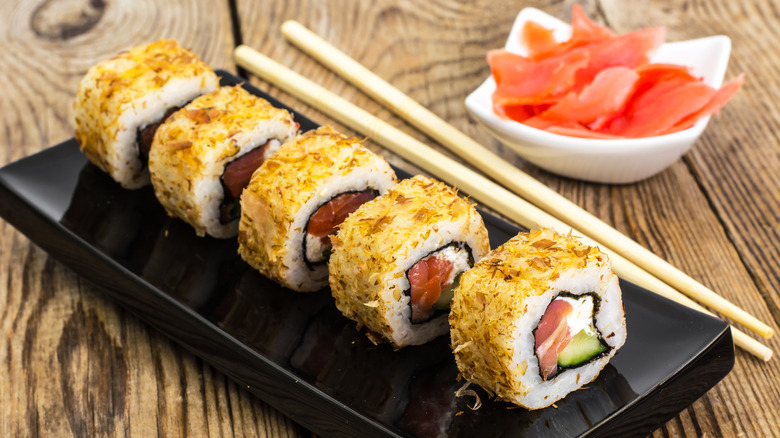
Shutterstock
Sushi might sound like a safe bet because rice is gluten-free, but Slusarek points out two hidden gluten sources: "Soy sauce and imitation crab!" Wait, soy sauce? Most soy sauce actually contains gluten because it's typically made with fermented wheat, but Slusarek recommends tamari as an alternative — it's made from just the soybeans without any wheat so is gluten-free. Be sure to ask if the restaurant has it "or bring your own," she says.
You also need to avoid miso soup, which often contains gluten, as miso is a fermented soy product made from soy beans and grain — and it can be hard to know whether the grain used is one that contains gluten or not unless you're a miso aficionado. Also note that dumplings, gyoza, and the batter in fried options like tempura shrimp and veggies may also have gluten.
So what to order? Slusarek recommends,"Stick with simple rolls or nigiri with gluten-free ingredients you know and make sure it's not hitting any soy sauce in the process." Another safe bet is sashimi. Enjoy edamame as an appetizer.
Chinese
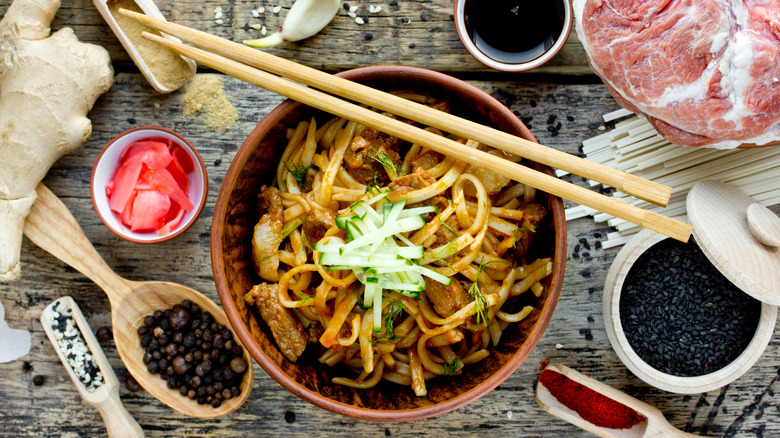
Shutterstock
Similar to Japanese cuisine, beware of soy sauce in Chinese food — make sure to ask about gluten-free tamari. Since many dishes you'll find in your typical Chinese restaurant include thick sauces with spices, ask about potential sources of gluten in sauces from thickeners or anti-caking agents in spice blends. You also want to avoid breaded items or noodles, wontons, and dumplings, unless you know they're gluten-free. Sorry to break it to you, but fortune cookies aren't gluten-free either.
So what should you order? I encourage my clients to order steamed chicken or fish and veggies and enjoy with brown rice. Choose a gluten-free sauce for dipping. Instead of a fortune cookie, enjoy orange slices, another common dessert at Chinese restaurants. Of course, there's no reason you can't crack open a cookie, so long as you don't eat it.
Burgers
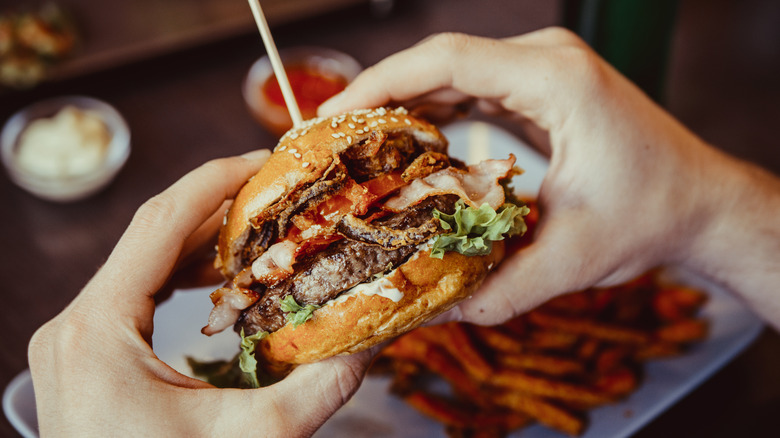
Shutterstock
The bun is an obvious source of gluten in a burger joint, but you also want to double-check about what's in the burgers themselves. It's not super-common, but some recipes call for breadcrumbs or flour. Ask about ingredients in sauces and condiments as well. Avoid breaded sides like onion rings and be aware that fries can also be a potential issue if they're fried in the same oil as items that do contain gluten.
Ask if gluten-free buns are available or enjoy your burger in lettuce cups or over a salad if they're not or there's no guarantee they're prepped in a separate area from gluten-containing ones. Make sure that salad is free of croutons, and keep dressing simple with oil and vinegar.
Mexican
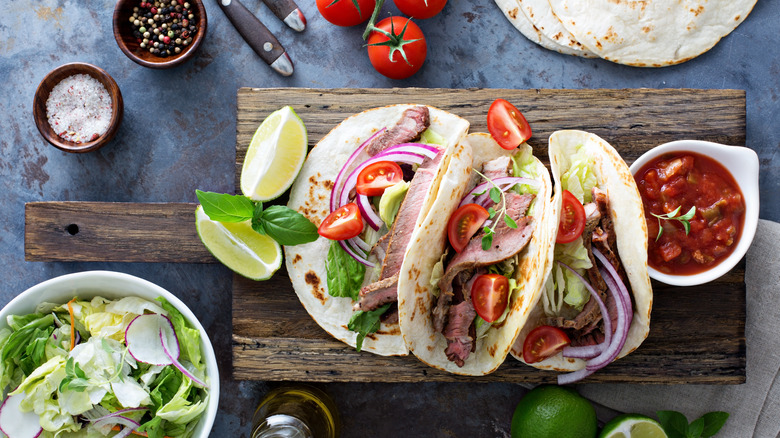
Shutterstock
The key to getting a gluten-free meal at a Mexican restaurant is to avoid flour tortillas and flour-thickened sauces. "Choose a 100 percent corn tortilla," Slusarek recommends, and ask about whether everything is prepared in the same area. While guac and salsa are usually safe bets, double check about the ingredients in sauces and condiments.
Here's one meal idea: enjoy the meat and veggies from a fajita platter with rice, beans, salsa, and guac. Lettuce wrap tacos are another delicious alternative.
If you're at a fast-food Mexican spot, try Slusarek's gluten-free go-to. "I choose the vegetarian [salad or burrito] bowl and load the lettuce with rice, beans, and veggies — and extra guac." You'll get a delicious, gluten-free balance of protein, complex carbs, fiber, veggies, and healthy fats.
Diner food
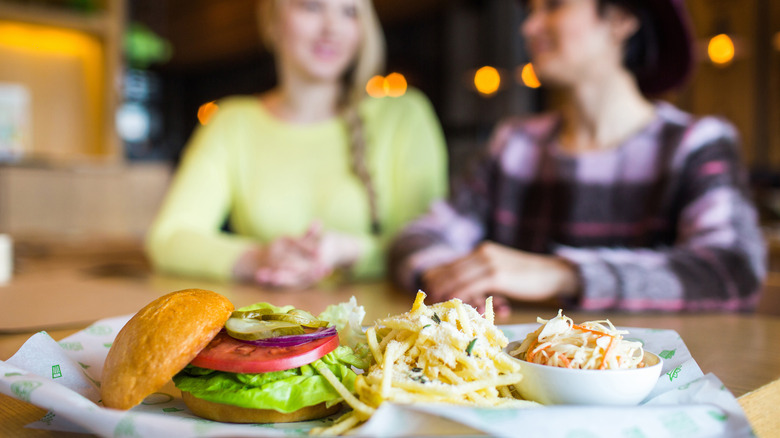
Shutterstock
Diners can be tricky but not impossible. You obviously want to avoid things with bread: sandwiches, burgers, toast, English muffins, and pastries. Same goes for pancakes, waffles, and blintzes. Cakes and pies are also on the "don't" list. Soups and gravies often contain gluten (especially if they're thickened with flour) so be careful with those too.
While some diners may have gluten-free bread, ask whether it's toasted in a separate toaster. You also want to stay away from breaded stuff like onion rings, mozzarella sticks, and chicken fingers. You're safer avoiding fries too, if there's no guarantee they're gluten-free and have been fried in separate oil.
When it comes to diners, I steer my clients towards things like eggs (poached is safest, since it doesn't hit the range everything else is cooked on), omelets, and salads. Just make sure that toast and croutons are left off. For something sweet, try cottage cheese or yogurt and fruit.
Middle Eastern
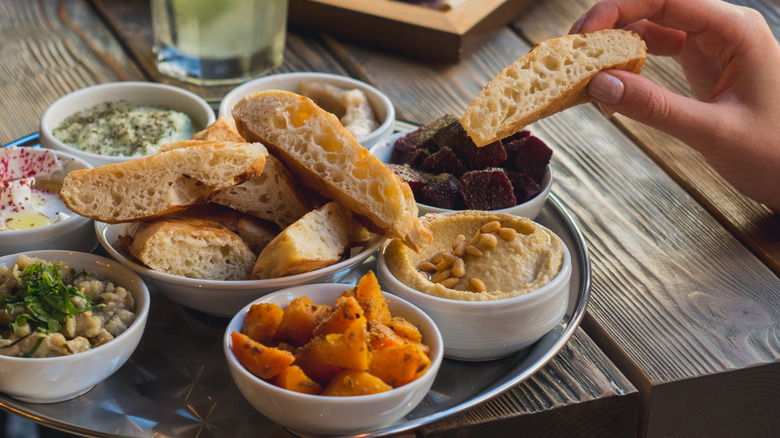
Shutterstock
At Middle Eastern restaurants, avoid things like couscous, tabbouleh, and pita. While hummus and babaganoush are generally gluten-free, double-check what the ingredients are. If your dining companions want to start with a hummus platter, ask for sliced vegetables as a pita alternative. To avoid cross-contamination from other people dipping pita, scoop out the portion of hummus you want onto your plate and dip your veggies into that.
Some grains to watch out for that have gluten are bulgur, farro, freekeh, and barley — do rice instead. You're likely safe with grilled meat and fish as your main. As long as you avoid fattoush salad, which has pita chips in it, salads are also generally a safe bet. Ask for olive oil and lemon juice or vinegar to use as a dressing. Shakshuka, egg cooked in tomato sauce, is another satisfying choice, but be sure to ask that bread be left off the plate. Falafel is a popular chickpea-based vegetarian item, but ask about whether they're fried in the same oil as foods that may contain gluten.
Vegetarian
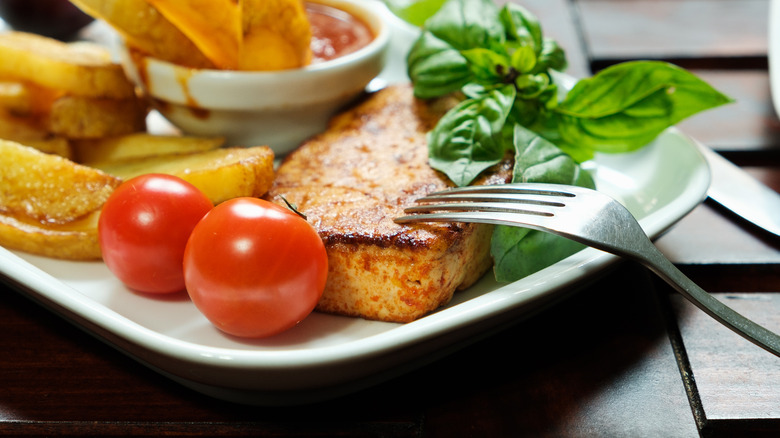
Shutterstock
A plant-based diet can be super-nourishing, but when dining out in a vegetarian restaurant, be mindful of which of those healthy whole grains contain gluten. If a gluten-free option like amaranth, corn, quinoa, millet, or sorghum isn't available, have beans or potato as your carb for the meal. To learn more about gluten-free grains, the Whole Grains Council provides detailed information.
Sauces that may contain flour or soy sauce can be sneaky sources of gluten, and if the restaurant serves "fake meat" products, ask what they're made from, especially if they contain breading. Some less-processed options like tofu and tempeh may be okay, but seitan, which is made from vital wheat gluten, is not. As with other restaurants, ask about whether gluten-free items are prepared in the same areas as those with gluten.
Salad bar
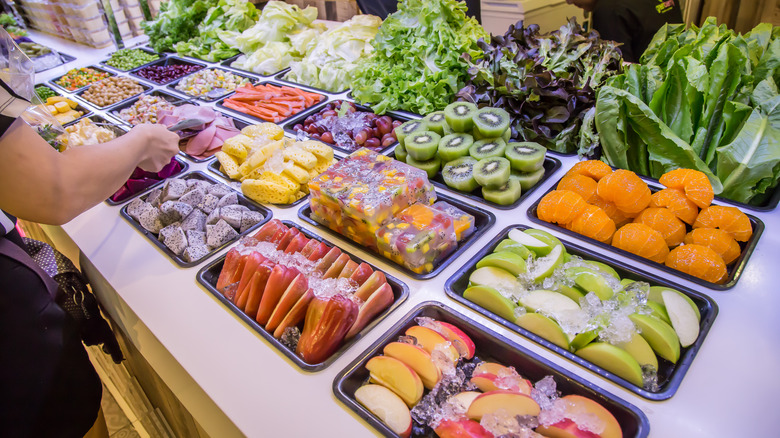
Shutterstock
Cross contamination is your main concern at a salad bar. Places where you serve yourself are the risky because you don't know if people are using the same utensil in multiple sections, but places where someone assembles and preps for you has its own risks.
Because the same cutting board may be used for multiple salads, even if your order contains only gluten-free items, it's possible that gluten from someone else's salad could end up in your bowl. Don't be shy about asking the person behind the counter to use a fresh cutting board.
Dressing is another risk. Slusarek recommends, "Choose vinaigrette dressing or oil and vinegar" to avoid potential gluten-containing thickeners in bottled dressings if ingredients lists aren't available.
Bakery treats

Shutterstock
Unless it's a certified gluten-free bakery or one that offers at least some certified gluten-free goods, "Don't even think about it," says Slusarek. However, French macarons are safe for celiacs and other gluten-free eaters because "these are generally made with [gluten-free] almond flour. Always be sure to ask, but this is one of my favorite gluten-free dessert choices!"
She also suggests ice cream as a sweet treat, but ask about ingredients and avoid anything like cookie dough, cookies, cake batter, or anything else that may contain gluten. Ask to see an ingredients list if you're not sure.
At the bar
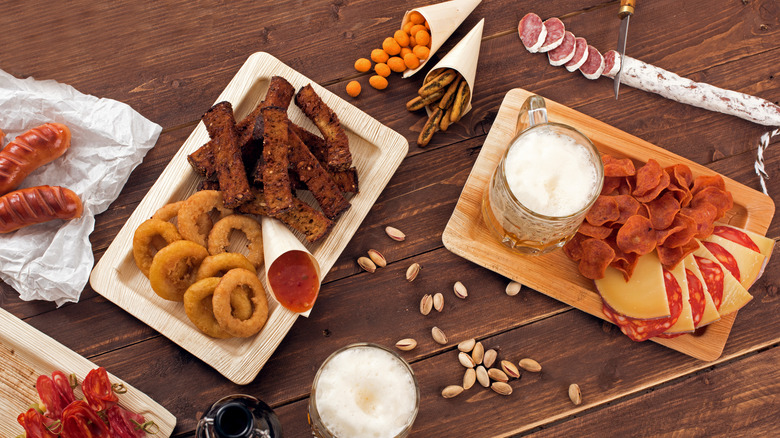
Shutterstock
True story: more than once I've been on a date with a guy who talked a big game about avoiding gluten "because it's so bad" (maybe he was trying to connect with my dietitian side?) as he sipped beer — and not gluten-free beer!
It may seem obvious, but just in case: beer contains gluten, as it's made from wheat, barley, or rye (all sources of gluten). However, some gluten-free beers are available, so ask the bartender. Ciders are a safer bet, as are wine and champagne. Rum, tequila, and vodka will generally be gluten-free, but whiskey and bourbon may not always be. While some distilled alcoholic beverages are made with gluten-containing grains, the Celiac Disease Foundation explains that the distilling process actually makes them gluten-free, as research suggests the gluten peptide is too large to carry through the distillation process and into the finished product. If you're a brown liquor fan, look up your favorite brands to make sure they're a safe option.
As far as bar snacks go, it can be tricky to find GF options amongst the fries, chips, nachos, sliders, and deep-fried (breaded) wings. Some safer choices are hummus with veggies instead of pita, chicken skewers (if the sauce is gluten-free), nuts, and olives. Not all bars have them, but if you're at an oyster happy hour spot, load up. Aside from being gluten-free, oysters are an awesome source of lean protein, vitamin B12, and zinc.
Don't be afraid to speak up

Shutterstock
Go in knowing that some restaurants are going to be more accommodating than others. Don't be afraid to speak up for your needs — your health and wellbeing are important! It can help to talk with your dining companions before you go if they don't know about your need to eat gluten-free; the heads-up can prevent awkwardness in the moment.
Remember, you're paying for the experience as well as the meal, so don't be shy to communicate clearly and ask for adjustments. If you need to send something back, please do — getting sick just isn't worth it.
Can Breading in Chicken Nuggets Trigger a Wheat Allergy?
Source: https://www.thelist.com/85824/worst-foods-order-restaurant-youre-gluten-free/
0 Response to "Can Breading in Chicken Nuggets Trigger a Wheat Allergy?"
Post a Comment